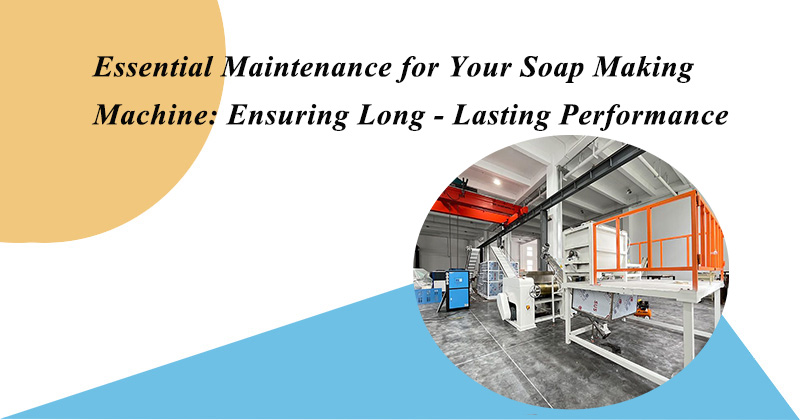A soap making machine is an invaluable asset for any soap – making business or enthusiast. Regular and proper maintenance not only extends the lifespan of the machine but also ensures consistent, high – quality soap production. In this blog, we’ll explore the key aspects of maintaining your soap making machine.
Cleaning: The Foundation of Maintenance
After Each Use
Removing Residual Ingredients
– As soon as you’ve finished a soap – making batch, start by emptying any remaining ingredients from the machine. For the hopper where you load oils, lye, and additives, use a soft brush or scraper to gently remove any stuck – on substances. Liquid ingredients can leave behind sticky residues, especially if they contain sugars or thickeners.
– In the mixing chamber, which is the heart of the machine where the magic of soap – making occurs, be extra careful. Use a non – abrasive cleaner and a soft cloth to wipe away soap batter. Avoid using harsh chemicals that could damage the surface of the chamber or react with future batches of soap.
Washing Detachable Parts
– Many soap making machines have detachable parts such as mixing blades, nozzles (if it has an extrusion feature), and molds. These parts should be removed and washed thoroughly with warm, soapy water. Scrub gently to remove any soap residue. Rinse them well and allow them to air – dry completely before reassembling. Moisture left on these parts can lead to corrosion over time.
Deep Cleaning
Monthly or Bi – Monthly
– At least once a month (or every two months depending on how frequently you use the machine), conduct a more in – depth cleaning. This includes using a mild degreaser to clean areas that are difficult to reach during regular cleaning, like the inner workings of the machine’s mechanical components. Make sure to follow the degreaser’s instructions carefully and rinse thoroughly to avoid any chemical residue that could contaminate future soap batches.
– For machines with heating elements, check for any build – up of soap scum or mineral deposits. A vinegar – and – water solution can be effective in removing these deposits. Let the solution sit on the affected areas for a while before gently scrubbing.
Lubrication: Keeping Things Moving Smoothly
Moving Parts
– Identify all the moving parts of your soap making machine, such as gears, pulleys, and hinges. These parts need regular lubrication to prevent wear and tear. Use a food – grade lubricant recommended by the machine’s manufacturer. Apply the lubricant sparingly but evenly to the moving parts, following the manufacturer’s guidelines on how often to lubricate. For example, gears may need lubrication every few weeks, while hinges might only need it once a month.
Checking for Proper Movement
– After lubricating, manually check the movement of the parts. Make sure there are no jerky motions or unusual resistance. Smooth operation is a sign that the lubrication has been done correctly and that the machine is in good working order.
Inspecting for Wear and Tear
Regular Visual Checks
– Conduct a visual inspection of the machine at least once a week. Look for any signs of damage, such as cracks in the hopper, mixing chamber, or molds. Check for loose screws or bolts that could cause parts to become misaligned. Pay attention to the condition of belts and chains (if applicable). If you notice any fraying or stretching, it’s time to consider replacement.
Testing Mechanical Functionality
– Periodically test the machine’s functions. Run it without any ingredients (dry – run) to check for any unusual noises, vibrations, or irregularities in the operation of the mixing mechanism, heating element (if it has one), or the extrusion/molding process. Unusual noises could indicate a problem with the bearings or other internal components.
Calibration: Ensuring Accuracy
Temperature and Speed Controls
– If your soap making machine has temperature and speed controls, it’s important to calibrate them regularly. Incorrect temperature settings can affect the saponification process, leading to poor – quality soap. Use a reliable thermometer to check the accuracy of the machine’s temperature readings. If there’s a deviation, follow the manufacturer’s instructions to recalibrate.
– Similarly, for speed controls, use a tachometer (if possible) to ensure that the mixing speed is as set. Incorrect mixing speeds can result in uneven soap texture or incomplete chemical reactions.
Ingredient Measuring Systems
– Some advanced soap making machines have built – in ingredient measuring systems. Calibrate these systems regularly to ensure accurate dosing of oils, lye, and other additives. Inaccurate measurements can lead to inconsistent soap quality and potentially dangerous situations when dealing with lye.
Storage: Protecting Your Machine When Not in Use
Indoor Storage
– Store your soap making machine in a clean, dry indoor area. Avoid storing it in areas with high humidity, such as basements or near water sources. Humidity can cause rust and corrosion, especially on metal parts.
Covering the Machine
– Use a dust cover or a plastic sheet to protect the machine from dust and debris when it’s not in use. This simple step can prevent dust from getting into the moving parts and the internal components of the machine, reducing the risk of malfunctions.
By following these maintenance tips, you can keep your soap making machine in top – notch condition, ensuring years of efficient and reliable service in your soap – making endeavors.

